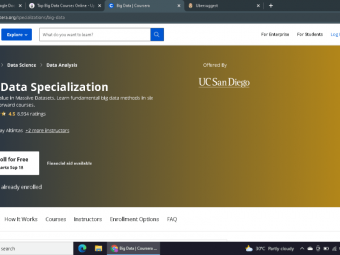Risk Management An Introduction
Tags: Risk Management
An essential guide to understanding Risk Management
Last updated 2022-01-10 | 3.7
- define risk management;- describe features of a risk management framework;
- define risk governance and describe elements of effective risk governance;
What you'll learn
* Requirements
* Students only need a computer or Android device with internet connectivity to view this courseDescription
Risk—and risk management—is an inescapable part of economic activity. People generally manage their affairs in order to be as happy and secure as their environment and resources will allow. But regardless of how carefully these affairs are managed, there is risk because the outcome, whether good or bad, is seldom predictable with complete certainty.
There is risk inherent in nearly everything we do, but this course will focus on economic and financial risk, particularly as it relates to investment management.
The questions that this course will address include the following:- What is risk management, and why is it important?
- What risks does an organization (or individual) face in pursuing its objectives?
- How are an entity’s goals affected by risk, and how does it make risk management decisions to produce better results?
- How does risk governance guide the risk management process and risk budgeting to integrate an organization’s goals with its activities?
- How does an organization measure and evaluate the risks it faces, and what tools does it have to address these risks?
This course is organized in five sections, the first section gives an Introduction to the concept of Risk Management, Section 2 describes the risk management process, and Section 3 discusses risk governance and risk tolerance. Section 4 covers the identification of various risks, and Section 5 addresses the measurement and management of risks.
Who this course is for:
- This course is ideal for a person seeking an introduction to Risk Management: Economic and Financial Risk
- Students appearing in CFA L1 exam for a second time must take this course as it is an addition in the 2016 curriculum
- Students enrolled for my Portfolio Management course do not need to take this as it has been embedded in that course
Course content
5 sections • 20 lectures
Introduction Preview 01:53
This lecture introduces the instructor and the course content
Introduction to Risk Management Preview 05:57
This lecture defines the Risk management process. Risk management is the process by which an organization or individual defines the level of risk to be taken, measures the level of risk being taken, and adjusts the latter toward the former, with the goal of maximizing the company’s or portfolio’s value or the individual’s overall satisfaction, or utility.
THE RISK MANAGEMENT PROCESS Preview 05:28
This lecture goes into the details of the risk management process. Taking risk is an active choice by boards and management, investment managers, and individuals. Risks must be understood and carefully chosen and managed.
Risk exposure is the extent to which an entity’s value may be affected through sensitivity to underlying risks.
Risk management is a process that defines risk tolerance and measures, monitors, and modifies risks to be in line with that tolerance.
Risk management framework Preview 05:19
This lecture discusses the risk management framework. A risk management framework is the infrastructure, processes, and analytics needed to support effective risk management; it includes risk governance, risk identification and measurement, risk infrastructure, risk policies and processes, risk mitigation and management, communication, and strategic risk analysis and integration.
The Risk Management Framework in an Enterprise Context Preview 09:19
This lecture talks about the Risk management framework in an Enterprise context
End of Section Quiz
An Enterprise View of Risk Governance Preview 04:53
In this lecture we take an enterprise view on Risk Governance. Risk governance is the top-level foundation for risk management, including risk oversight and setting risk tolerance for the organization.
Risk identification and measurement is the quantitative and qualitative assessment of all potential sources of risk and the organization’s risk exposures.
Risk infrastructure comprises the resources and systems required to track and assess the organization’s risk profile.
Risk policies and processes are management’s complement to risk governance at the operating level.
Risk mitigation and management is the active monitoring and adjusting of risk exposures, integrating all the other factors of the risk management framework.
Communication includes risk reporting and active feedback loops so that the risk process improves decision making.
Strategic risk analysis and integration involves using these risk tools to rigorously sort out the factors that are and are not adding value as well as incorporating this analysis into the management decision process, with the intent of improving outcomes.
Employing a risk management committee, along with a chief risk officer (CRO), are hallmarks of a strong risk governance framework.
Governance and the entire risk process should take an enterprise risk management perspective to ensure that the value of the entire enterprise is maximized.
Risk Tolerance Preview 05:03
We understand Risk tolerance through this lecture. Risk tolerance, a key element of good risk governance, delineates which risks are acceptable, which are unacceptable, and how much risk the overall organization can be exposed to.
Risk Budgeting Preview 04:32
This lecture discusses risk budgeting, which is any means of allocating investments or assets by their risk characteristics.
End of Section Quiz
Financial Risks Preview 03:28
This lecture discusses Financial risks, which are those that arise from activity in the financial markets.
Financial risks consist of market risk, credit risk, and liquidity risk.
Market risk arises from movements in stock prices, interest rates, exchange rates, and commodity prices.
Credit risk is the risk that a counterparty will not pay an amount owed.
Liquidity risk is the risk that, as a result of degradation in market conditions or the lack of market participants, one will be unable to sell an asset without lowering the price to less than the fundamental value.
Non-Financial Risks Preview 08:00
This lecture discusses Non-financial risks that arise from actions within an entity or from external origins, such as the environment, the community, regulators, politicians, suppliers, and customers.
Non-financial risks consist of a variety of risks, including settlement risk, operational risk, legal risk, regulatory risk, accounting risk, tax risk, model risk, tail risk, and sovereign or political risk.
Operational risk is the risk that arises from within the operations of an organization and includes both human and system or process errors.
Solvency risk is the risk that the entity does not survive or succeed because it runs out of cash to meet its financial obligations.
Individuals face many of the same organizational risks outlined here but also face health risk, mortality or longevity risk, and property and casualty risk.
Interactions between Risks Preview 05:10
This lecture discusses the interaction among risks and talks about their relation ships. Risks are not necessarily independent because many risks arise as a result of other risks; risk interactions can be extremely non-linear and harmful.
End of Section Quiz
Risk Drivers Preview 04:32
Risk drivers are the fundamental global and domestic macroeconomic and industry factors that create risk.
Risk Metrics Preview 08:34
Common measures of risk include standard deviation or volatility; asset-specific measures, such as beta or duration; derivative measures, such as delta, gamma, vega, and rho; and tail measures such as value at risk, CVaR and expected loss given default.
Methods of Risk Modification Preview 13:54
Risk can be modified by prevention and avoidance, risk transfer (insurance), or risk shifting (derivatives).
Risk can be mitigated internally through self-insurance or diversification.
The primary determinants of which method is best for modifying risk are the benefits weighed against the costs, with consideration for the overall final risk profile and adherence to risk governance objectives.
THE RISK MANAGEMENT PROCESS FOR AN INDIVIDUAL Preview 13:28
This lecture discusses risk management from an Individual's perspective








 This course includes:
This course includes:
















